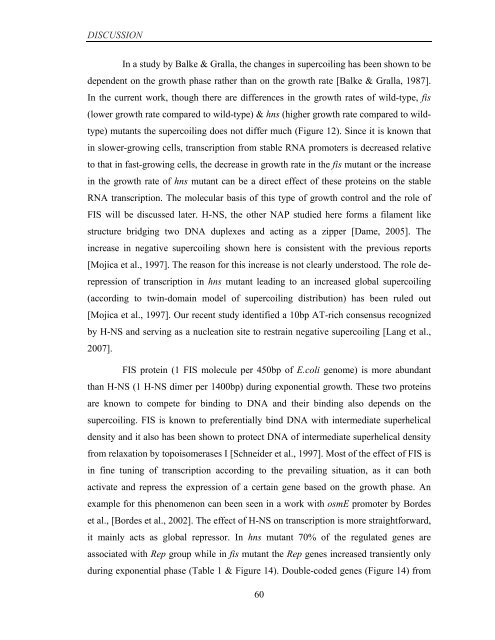Coordinated regulation of gene expression by E ... - Jacobs University
Coordinated regulation of gene expression by E ... - Jacobs University
Coordinated regulation of gene expression by E ... - Jacobs University
You also want an ePaper? Increase the reach of your titles
YUMPU automatically turns print PDFs into web optimized ePapers that Google loves.
DISCUSSION<br />
In a study <strong>by</strong> Balke & Gralla, the changes in supercoiling has been shown to be<br />
dependent on the growth phase rather than on the growth rate [Balke & Gralla, 1987].<br />
In the current work, though there are differences in the growth rates <strong>of</strong> wild-type, fis<br />
(lower growth rate compared to wild-type) & hns (higher growth rate compared to wildtype)<br />
mutants the supercoiling does not differ much (Figure 12). Since it is known that<br />
in slower-growing cells, transcription from stable RNA promoters is decreased relative<br />
to that in fast-growing cells, the decrease in growth rate in the fis mutant or the increase<br />
in the growth rate <strong>of</strong> hns mutant can be a direct effect <strong>of</strong> these proteins on the stable<br />
RNA transcription. The molecular basis <strong>of</strong> this type <strong>of</strong> growth control and the role <strong>of</strong><br />
FIS will be discussed later. H-NS, the other NAP studied here forms a filament like<br />
structure bridging two DNA duplexes and acting as a zipper [Dame, 2005]. The<br />
increase in negative supercoiling shown here is consistent with the previous reports<br />
[Mojica et al., 1997]. The reason for this increase is not clearly understood. The role derepression<br />
<strong>of</strong> transcription in hns mutant leading to an increased global supercoiling<br />
(according to twin-domain model <strong>of</strong> supercoiling distribution) has been ruled out<br />
[Mojica et al., 1997]. Our recent study identified a 10bp AT-rich consensus recognized<br />
<strong>by</strong> H-NS and serving as a nucleation site to restrain negative supercoiling [Lang et al.,<br />
2007].<br />
FIS protein (1 FIS molecule per 450bp <strong>of</strong> E.coli genome) is more abundant<br />
than H-NS (1 H-NS dimer per 1400bp) during exponential growth. These two proteins<br />
are known to compete for binding to DNA and their binding also depends on the<br />
supercoiling. FIS is known to preferentially bind DNA with intermediate superhelical<br />
density and it also has been shown to protect DNA <strong>of</strong> intermediate superhelical density<br />
from relaxation <strong>by</strong> topoisomerases I [Schneider et al., 1997]. Most <strong>of</strong> the effect <strong>of</strong> FIS is<br />
in fine tuning <strong>of</strong> transcription according to the prevailing situation, as it can both<br />
activate and repress the <strong>expression</strong> <strong>of</strong> a certain <strong>gene</strong> based on the growth phase. An<br />
example for this phenomenon can been seen in a work with osmE promoter <strong>by</strong> Bordes<br />
et al., [Bordes et al., 2002]. The effect <strong>of</strong> H-NS on transcription is more straightforward,<br />
it mainly acts as global repressor. In hns mutant 70% <strong>of</strong> the regulated <strong>gene</strong>s are<br />
associated with Rep group while in fis mutant the Rep <strong>gene</strong>s increased transiently only<br />
during exponential phase (Table 1 & Figure 14). Double-coded <strong>gene</strong>s (Figure 14) from<br />
60
















